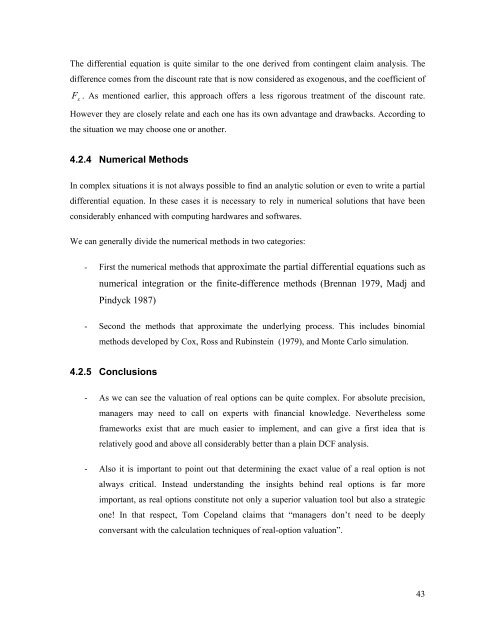Managing Risks of Supply-Chain Disruptions: Dual ... - CiteSeerX
Managing Risks of Supply-Chain Disruptions: Dual ... - CiteSeerX
Managing Risks of Supply-Chain Disruptions: Dual ... - CiteSeerX
Create successful ePaper yourself
Turn your PDF publications into a flip-book with our unique Google optimized e-Paper software.
The differential equation is quite similar to the one derived from contingent claim analysis. Thedifference comes from the discount rate that is now considered as exogenous, and the coefficient <strong>of</strong>Fx. As mentioned earlier, this approach <strong>of</strong>fers a less rigorous treatment <strong>of</strong> the discount rate.However they are closely relate and each one has its own advantage and drawbacks. According tothe situation we may choose one or another.4.2.4 Numerical MethodsIn complex situations it is not always possible to find an analytic solution or even to write a partialdifferential equation. In these cases it is necessary to rely in numerical solutions that have beenconsiderably enhanced with computing hardwares and s<strong>of</strong>twares.We can generally divide the numerical methods in two categories:- First the numerical methods that approximate the partial differential equations such asnumerical integration or the finite-difference methods (Brennan 1979, Madj andPindyck 1987)- Second the methods that approximate the underlying process. This includes binomialmethods developed by Cox, Ross and Rubinstein (1979), and Monte Carlo simulation.4.2.5 Conclusions- As we can see the valuation <strong>of</strong> real options can be quite complex. For absolute precision,managers may need to call on experts with financial knowledge. Nevertheless someframeworks exist that are much easier to implement, and can give a first idea that isrelatively good and above all considerably better than a plain DCF analysis.- Also it is important to point out that determining the exact value <strong>of</strong> a real option is notalways critical. Instead understanding the insights behind real options is far moreimportant, as real options constitute not only a superior valuation tool but also a strategicone! In that respect, Tom Copeland claims that “managers don’t need to be deeplyconversant with the calculation techniques <strong>of</strong> real-option valuation”.43
















